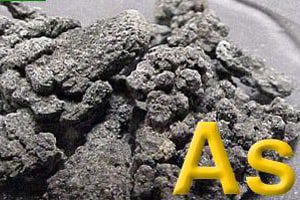
An emerging study found that high levels of arsenic and other heavy metals are present in groundwater located near hydraulic fracturing (fracking) sites in the Barnett Shale located in Texas. The Barnet shale comprises some 5,000 square miles in northern Texas and consists of 17 counties in that state, according to the WVGazette.com. Researchers at […]
 An emerging study found that high levels of arsenic and other heavy metals are present in groundwater located near hydraulic fracturing (fracking) sites in the Barnett Shale located in Texas.
An emerging study found that high levels of arsenic and other heavy metals are present in groundwater located near hydraulic fracturing (fracking) sites in the Barnett Shale located in Texas.
The Barnet shale comprises some 5,000 square miles in northern Texas and consists of 17 counties in that state, according to the WVGazette.com.
Researchers at the University of Texas at Arlington conducted the research, adding to mounting evidence that arsenic and other heavy metal contamination near natural gas fracking sites may be associated with fracking activities. According to the Aspen Business Journal, a presentation that the The Los Angeles Times obtained, discussed increased arsenic levels in groundwater near wells in Dimock, Pennsylvania. In 2009, the U.S. Environmental Protection Agency (EPA) found arsenic in the groundwater near Pavillion, Wyoming fracking sites; however, that study was later abandoned by the agency, according to the Aspen Business Journal.
Brian Fontenot, this study’s lead author, sought clarification concerning the impact of fracking activities on the environment and to also bring an unbiased perspective to the matter, he told ProPublica. Fontenot and study author, Laura Hunt, both work for the EPA in Dallas, and conducted this study on their free time, collaborating with UT Arlington researchers,
According to Fontenot, other, similar studies have been conducted in the Marcellus Shale. The Marcellus Shale is located beneath a number of states, including Pennsylvania and New York, and is believed to contain billions of dollars in natural gas reserves. This team visited private landowner wells, sampling and assaying water for a number of things including the known fracturing chemicals listed in a Congressional report, according to ProPublica. Fontenot says his study was neither pro-industry nor anti-fracking and was conducted to obtain scientific data.
The team worked nights and weekends, in accordance with their agreement with the EPA to work on the study outside of work hours. The team collected about 100 samples both near and away from the Barnett Shale and from fracking sites. Samples were taken from actual water sources and each sample involved a 20-minute purge to ensure that only fresh water from within the aquifer was obtained, which is as close as possible to groundwater, ProPublica explained.
The team tested for volatile organic compounds, heavy metals, methanols, alcohols, and other dangerous elements and the tests revealed what the team described as a number of “elevated constituents” such as heavy metals, specifically arsenic, selenium, and strontium. The metals all tested at levels that exceeded the EPA’s maximum contaminate limit for drinking water, as well as at levels exceeding what would be considered naturally occurring, according to ProPublica. Some samples revealed measureable levels of methanol and ethanol, which do not occur naturally in groundwater. Fontenot explained that when methanol or ethanol is detected in the environment at the levels the team saw, those levels point to a continuous source.
Arsenic levels in fracking areas were seen at about 18 times higher than in non-fracking areas and the metal levels seen were at concentrations not considered normal. While fracking water leaks might not always be involved, because of the number of steps involved in the fracking process that could be to blame, it is possible that fracking steps could cause naturally occurring heavy metals—and not the metals used in fracking recipes—to concentrate in unusual ways.
Fracking involves the horizontal injection of tons of silica sand, a huge mix of more than 600 chemicals, and water, at least one mile beneath the earth’s surface. The fracking mixture is shot into a concrete well that extends to a bed of shale rock that is located deep underground. When the fracking cocktail reaches the rock, the rock is blasted apart and natural gas is released and supposed to be returned to the surface and captured; most of the water remains underground. Industry has injected more than 30 trillion gallons of toxic fracking wastewater deep into the earth.
Underground injection wells for disposing fracking wastewater have been used since the 1960s and more and more fluid been used in the process in recent years, creating a massive amount of wastewater and the need for more disposal sites. Previous studies suggest that the briny, salty nature of drilling fluids lubricates underground rock. Should the site of the underground well be located near a natural fault line, wastewater may eventually cause the rocks to shift, a phenomena some believe is tied to increased seismic activity.


